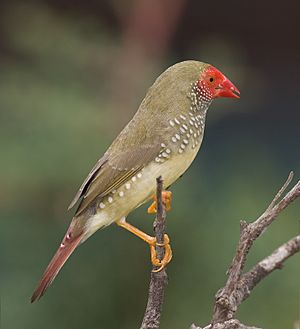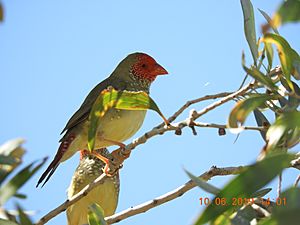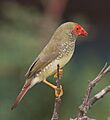Star finch facts for kids
Quick facts for kids Star finch |
|
|---|---|
 |
|
| Conservation status | |
| Scientific classification |
The star finch (Bathilda ruficauda) is a small bird that eats seeds. You can find it in northern Australia. It has a special red face and beak, and big white spots on its sides. Sadly, one of its three types might have disappeared forever.
Contents
What Does the Star Finch Look Like?
The star finch is a type of finch. It is about 10 to 12 centimeters (4 to 5 inches) long. It has a bright red face and a red beak. Its top and bottom feathers are yellow-green. It has white spots on its belly, which is more yellow. The feathers on its upper tail are red, and its tail feathers are reddish-brown.
Female star finches have less red on their heads. They also look a bit duller than the males. Young star finches are olive to brownish. They have a grey face and head. The wide white spots under its chin and on its sides give it the name "star finch." Its wingspan is about 49 to 56 millimeters (about 2 inches). Its beak is 11 to 13 millimeters long. This little bird weighs about 10 to 12 grams (less than half an ounce).
Star Finch Names and History
The scientific name for the star finch is Bathilda ruficauda. It used to be called Poephila ruficauda or Neochmia ruficauda. People also call it the red-faced firetail or red-tailed finch. The name "red-tailed finch" was first used in 1884. It was common until 1926. That's when the name "star finch" appeared in a bird checklist. No one knows why the name changed.
Two explorers, Hombron and Jacquinot, first saw these birds. This happened during a French trip to Antarctica from 1837 to 1840. They stopped in Australia on their journey. Hombron first put the bird in a group called Erythura. But he thought its short legs might mean it needed a new group. This new group was named Neochimia. Gray started using this name in 1849. The word neokhmos comes from Greek and means "new." So, Neochimia means "new bird."
The species name ruficauda comes from Latin. Rufus means red, and cauda means tail. So, ruficauda means "red-tailed."
There are three known types, or subspecies, of the star finch:
- Bathilda ruficauda subclarescens (named by Mathews in 1912): This type is found in Western Australia and the Northern Territory.
- Bathilda ruficauda clarescens (named by Hartert in 1899): This type lives on the Cape York Peninsula in northern Queensland.
- Bathilda ruficauda ruficauda (named by Gould in 1837): This type is found along the coast of northern Queensland. It might be extinct now.

Where Star Finches Live and How They Are Protected
The IUCN Red List of Threatened Species says the star finch is of "Least Concern." This means it's not in great danger globally. Even though its numbers might be slowly going down, many large groups of these birds still exist.
However, in New South Wales, the Bathilda ruficauda is thought to be extinct. In the Northern Territory, its population is listed as "Near Threatened."
The subclarescens subspecies lives in three separate areas. These areas are in Western Australia and the western Northern Territory. There might be 200,000 of these birds. Their numbers seem to be decreasing in some places. But they are common in the Victoria River and Daly River areas. They are also found near Kununurra because of a big irrigation project. This type is often called the Western star finch.
The clarescens subspecies lives on the Cape York Peninsula. It has about 3,500 birds, and their numbers are stable. But they are spread out in patches. This type is called the Cape York star finch. In Queensland, it is also listed as "Least Concern."
The ruficauda subspecies is known as the Southern star finch. It is believed that fewer than 50 of these birds are left. It might even be extinct. The last time someone reliably saw one was in 1994. Under Australian law, this type is considered "Endangered." In Queensland, it is also listed as "Endangered."
Star Finch Behavior and Habitat
These finches live in low, thick, damp grasslands and areas with sedges. These places are usually next to rivers, swamps, or other freshwater bodies. They also live in open, grassy woodlands. Sometimes, you can even find them in towns.
Star finches often gather in groups of 10 to 30 birds. Sometimes, these groups can grow to hundreds! They eat seeds. They look for food in plants just above the ground. They also often feed on the ground, especially when it's dry. They build their nests like a ball of grass. They line the inside with feathers. Females lay 3 to 7 white eggs.
The places where star finches live are in danger. Too much grazing by animals can remove the grass they need for cover and food. Also, if certain grasses are eaten too much during the wet season, the finches might not have enough food in the dry season. Fires in grasslands during the dry season can also reduce the seeds available for them to eat. This bird is also threatened by people catching them to keep as pets.
Star Finches as Pets
The star finch is a common aviary bird. People say they are easy to breed. There are many different color changes, or mutations, of this bird. The most common is the Yellow Star. Other types include fawn, cinnamon, and pied (mixed colors). These can come in both normal and yellow forms. Yellow-faced star finches are sometimes called Buddha finches. This is because they are very peaceful birds, and their mango yellow color looks like a Buddhist monk's robe.
Images for kids
See also
 In Spanish: Diamante colirrojo para niños
In Spanish: Diamante colirrojo para niños




